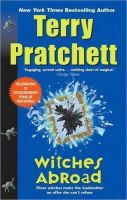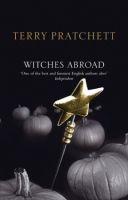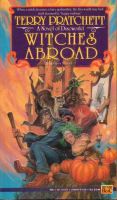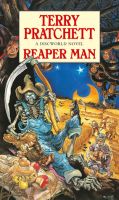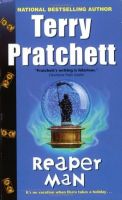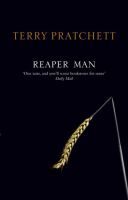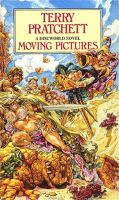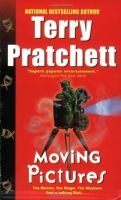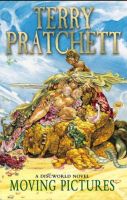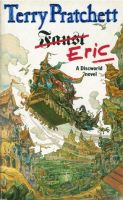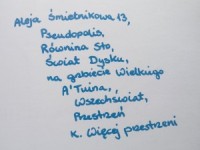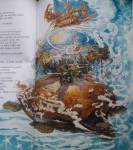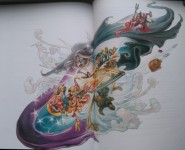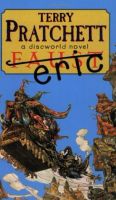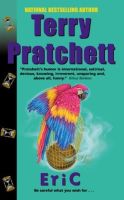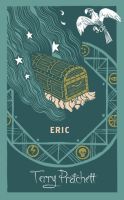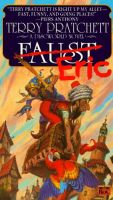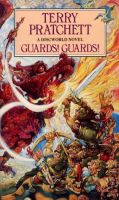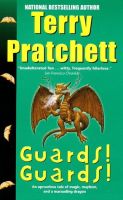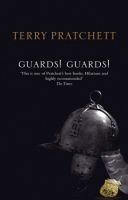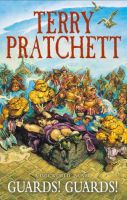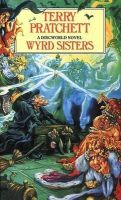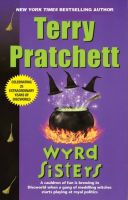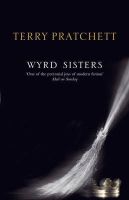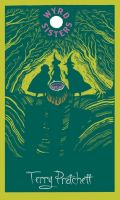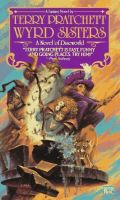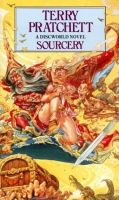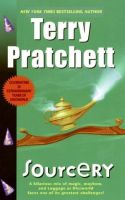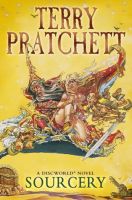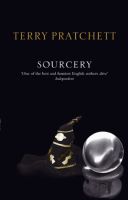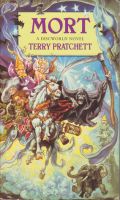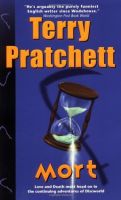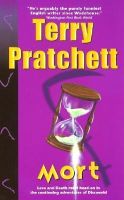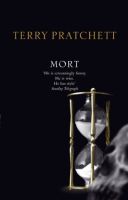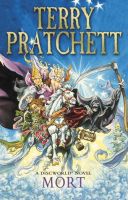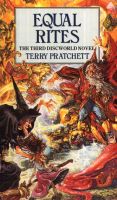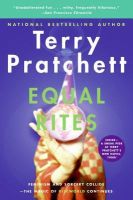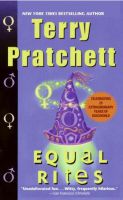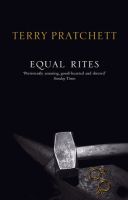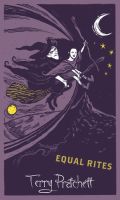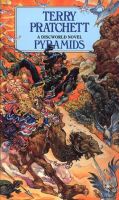 Title:Pyramids
Title:Pyramids
Author(s): Terry Pratchett
Release year: 1989
Publisher: Gollancz
Why in Database: Pyramids is the seventh book in the Discworld series, and the second (after the Small Gods) book in this series in terms of the intensity of the turtle elements. And since every fragment is important and they are long, we show them all. Pretty standard, at first, A’Tuin:
For, as the world tumbles lazily, it is revealed as the Discworld—flat, circular, and carried through space on the back of four elephants who stand on the back of Great A’tuin, the only turtle ever to feature on the Hertzsprung-Russell Diagram, a turtle ten thousand miles long, dusted with the frost of dead comets, meteor-pocked, albedo-eyed. No one knows the reason for all this, but it is probably quantum.
Much that is weird could happen on a world on the back of a turtle like that.
The next two mentions (they appear separately) are a kind of introduction to long passages present later in the book:
The energy streaming up from their paracosmic peaks may, in chapters to come, illuminate many mysteries: why tortoises hate philosophy, why too much religion is bad for goats, and what it is that handmaidens actually do.
But that was an old dream, he dreamed that one nearly every night… And then there was a man firing arrows at a tortoise…
The first of the long turtle fragments, well answering the question why turtles does not like (some) philosophers (it is also a reference to paradox of Achilles and the Tortoise):
Teppic conceded this, rather reluctantly, and eased himself cautiously up the sliding surface of the dune. The voices were arguing again:
“Give in?”
“We simply haven’t got all the parameters right.”
“I know what we haven’t got all right.”
“What is that, pray?”
“We haven’t got anymore bloody tortoises. That’s what we haven’t got.”
Teppic carefully poked his head over the top of the dune. He saw a large cleared area, surrounded by complicated ranks of markers and flags. There were one or two buildings in it, mostly consisting of cages, and several other intricate constructions he could not recognize. In the middle of it all were two men—one small, fat and florid, the other tall and willowy and with an indefinable air of authority. They were wearing sheets. Clustered around them, and not wearing very much at all, was a group of slaves. One of them was holding a bow.
Several of them were holding tortoises on sticks. They looked a bit pathetic, like tortoise lollies.
“Anyway, it’s cruel,” said the tall man. “Poor little things. They look so sad with their little legs waggling.”
“It’s logically impossible for the arrow to hit them!” The fat man threw up his hands. “It shouldn’t do it! You must be giving me the wrong type of tortoise,” he added accusingly. “We ought to try again with faster tortoises.”
“Or slower arrows?”
“Possibly, possibly.”
Teppic was aware of a faint scuffling by his chin. There was a small tortoise scurrying past him. It had several ricochet marks on its shell.
“We’ll have one last try,” said the fat man. He turned to the slaves. “You lot—go and find that tortoise.”
The little reptile gave Teppic a look of mingled pleading and hope. He stared at it, and then lifted it up carefully and tucked it behind a rock.
He slid back down the dune to Ptraci.
“There’s something really weird going on over there,” he said. “They’re
shooting tortoises.”
“Why?”
“Search me. They seem to think the tortoise ought to be able to run away.”
“What, from an arrow?”
“Like I said. Really weird. You stay here. I’ll whistle if it’s safe to follow me.”
The topic of what these philosophers actually do is expanded:
“Xeno’s the name,” gasped the fat man, before he could speak. “Are you hurt? We did put up warning signs, I’m sure. Did you come in over the desert? You must be thirsty. Would you like a drink? Who are you? You haven’t seen a tortoise up there, have you? Damned fast things, go like greased thunderbolts, there’s no stopping the little buggers.”
Teppic deflated again.
“Tortoises?” he said. “Are we talking about those, you know, stones on legs?”
“That’s right, that’s right,” said Xeno. “Take your eyes off them for a second, and vazoom!”
“Vazoom?” said Teppic. He knew about tortoises. There were tortoises in the Old Kingdom. They could be called a lot of things—vegetarians, patient, thoughtful, even extremely diligent and persistent sex-maniacs—but never, up until now, fast. Fast was a word particularly associated with tortoises because they were not it.
“Are you sure?” he said.
“Fastest animal on the face of the Disc, your common tortoise,” said Xeno, but he had the grace to look shifty. “Logically, that is,” he added.*.
The tall man gave Teppic a nod.
“Take no notice of him, boy,” he said. “He’s just covering himself because of the accident last week.”
“The tortoise did beat the hare,” said Xeno sulkily.
“The hare was dead, Xeno,” said the tall man patiently. “Because you shot it.”
“I was aiming at the tortoise. You know, trying to combine two experiments, cut down on expensive research time, make full use of available—” Xeno gestured with the bow, which now had another arrow in it.
“Excuse me,” said Teppic. “Could you put it down a minute? Me and my friend have come a long way and it would be nice not to be shot at again.”
These two seem harmless, he thought, and almost believed it.
He whistled. On cue, Ptraci came around the dune, leading You Bastard. Teppic doubted the capability of her costume to hold any pockets whatsoever, but she seemed to have been able to repair her make-up, re-kohl her eyes and put up her hair. She undulated toward the group like a snake in a skid, determined to hit the strangers with the full force of her personality. She was also holding something in her other hand.
“She’s found the tortoise!” said Xeno. “Well done!”
The reptile shot back into its shell. Ptraci glared. She didn’t have much in the world except herself, and didn’t like to be hailed as a mere holder of testudinoids.
The tall man sighed. “You know, Xeno,” he said, “I can’t help thinking you’ve got the wrong end of the stick with this whole tortoise-and-arrow business.”
The little man glared at him.
“The trouble with you, Ibid,” he said, “is that you think you’re the biggest bloody authority on everything.”
There is also a scene in which someone takes care of the turtle:
Ptraci sat under the tree, feeding the tortoise on vine leaves.
Further attempts to explain the “experiment”:
“But I still don’t understand about the tortoise,” he said, with some difficulty. He’d just taken his first mouthful of Ephebian wine, and it had apparently varnished the back of his throat.
“’S quite simple,” said Xeno. “Look, let’s say this olive stone is the arrow and this, and this—” he cast around aimlessly—“and this stunned seagull is the tortoise, right? Now, when you fire the arrow it goes from here to the seag—the tortoise, am I right?”
“I suppose so, but—”
“But, by this time, the seagu—the tortoise has moved on a bit, hasn’t he? Am I right?”
“I suppose so,” said Teppic, helplessly. Xeno gave him a look of triumph.
“So the arrow has to go a bit further, doesn’t it, to where the tortoise is now. Meanwhile the tortoise has flow—moved on, not much, I’ll grant you, but it doesn’t have to be much. Am I right? So the arrow has a bit further to go, but the point is that by the time it gets to where the tortoise is now the tortoise isn’t there. So, if the tortoise keeps moving, the arrow will never hit it. It’ll keep getting closer and closer but never hit it. QED.”
“Are you right?” said Teppic automatically.
“No,” said Ibid coldly. “There’s a dozen tortoise kebabs to prove him wrong. The trouble with my friend here is that he doesn’t know the difference between a postulate and a metaphor of human existence. Or a hole in the ground.”
Ptraci still takes care for the turtle:
“There is that,” Xeno agreed. “Especially for dead people.”There was an embarrassed silence, broken only by Ptraci’s voice singing to the tortoise and the occasional squeak of stricken seagulls.
An interesting fragment, because it can be considered a kind of preview of another turtle book from Discworld, Small Gods:
He found Ptraci sitting on the grass under a poplar tree, feeding the tortoise. He gave it a suspicious look, in case it was a god trying it on. It did not look like a god. If it was a god, it was putting on an incredibly good act.
She was feeding it a lettuce leaf.
“Dear little tortoise,” she said, and then looked up. “Oh, it’s you,” she said flatly.
A turtle related comparison:
Gern’s biceps moved like turtles in grease.
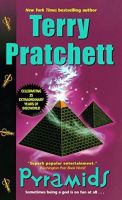
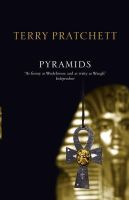
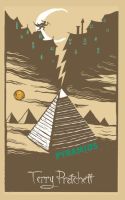
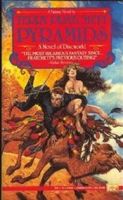
Author: XYuriTT
 Title: Witches Abroad
Title: Witches Abroad